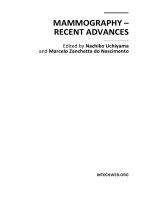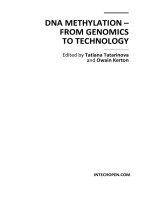The Human Embryo Edited by Shigehito Yamada and Tetsuya Takakuwa doc
Bạn đang xem bản rút gọn của tài liệu. Xem và tải ngay bản đầy đủ của tài liệu tại đây (30 MB, 192 trang )
THE HUMAN EMBRYO
Edited by Shigehito Yamada
and Tetsuya Takakuwa
The Human Embryo
Edited by Shigehito Yamada and Tetsuya Takakuwa
Published by InTech
Janeza Trdine 9, 51000 Rijeka, Croatia
Copyright © 2012 InTech
All chapters are Open Access distributed under the Creative Commons Attribution 3.0
license, which allows users to download, copy and build upon published articles even for
commercial purposes, as long as the author and publisher are properly credited, which
ensures maximum dissemination and a wider impact of our publications. After this work
has been published by InTech, authors have the right to republish it, in whole or part, in
any publication of which they are the author, and to make other personal use of the
work. Any republication, referencing or personal use of the work must explicitly identify
the original source.
As for readers, this license allows users to download, copy and build upon published
chapters even for commercial purposes, as long as the author and publisher are properly
credited, which ensures maximum dissemination and a wider impact of our publications.
Notice
Statements and opinions expressed in the chapters are these of the individual contributors
and not necessarily those of the editors or publisher. No responsibility is accepted for the
accuracy of information contained in the published chapters. The publisher assumes no
responsibility for any damage or injury to persons or property arising out of the use of any
materials, instructions, methods or ideas contained in the book.
Publishing Process Manager Ivana Zec
Technical Editor Teodora Smiljanic
Cover Designer InTech Design Team
First published February, 2012
Printed in Croatia
A free online edition of this book is available at www.intechopen.com
Additional hard copies can be obtained from
The Human Embryo, Edited by Shigehito Yamada and Tetsuya Takakuwa
p. cm.
ISBN 978-953-51-0124-6
Contents
Preface IX
Part 1 Introduction 1
Chapter 1 Introduction – Developmental
Overview of the Human Embryo 3
Shigehito Yamada and Tetsuya Takakuwa
Chapter 2 Presenting Human Embryology in an
International Open-Access Reference Centre (HERC) 21
Beate Brand-Saberi, Edgar Wingender,
Otto Rienhoff and Christoph Viebahn
Part 2 Implantation 35
Chapter 3 Optimal Environment for the
Implantation of Human Embryo 37
Paweł Kuć
Chapter 4 Immune Regulation of Human Embryo
Implantation by Circulating Blood Cells 61
Hiroshi Fujiwara, Yukiyasu Sato, Atsushi Ideta,
Yoshito Aoyagi, Yoshihiko Araki and Kazuhiko Imakawa
Chapter 5 The Future of Human Embryo
Culture Media – Or Have We Reached the Ceiling? 73
Deirdre Zander-Fox and Michelle Lane
Chapter 6 Benzo[a]pyrene and Human Embryo 99
Shi Jiao, Bingci Liu and Meng Ye
Part 3 Organogenesis and Genetics 109
Chapter 7 Developmental Anatomy of the Human Embryo –
3D-Imaging and Analytical Techniques 111
Shigehito Yamada, Takashi Nakashima, Ayumi Hirose,
Akio Yoneyama, Tohoru Takeda and Tetsuya Takakuwa
VI Contents
Chapter 8 Cardiovascular Development in the First Trimester 127
Preeta Dhanantwari, Linda Leatherbury and Cecilia W. Lo
Chapter 9 Development, Differentiation and Derivatives
of the Wolffian and Müllerian Ducts 143
Monika Jacob, Faisal Yusuf and Heinz Jürgen Jacob
Chapter 10 Cytogenetic Analysis of Spontaneous Miscarriage 167
Nobuaki Ozawa
Preface
Human embryology is now rapidly moving to a new phase due to recent innovation
and advances of life science including ES and iPS technology. This new era also
directs a difficult challenge for scientists in terms of technological and ethical issues
for future human embryology. However, human embryology is difficult to research
due to ethics involved in the collection of human materials. This book traces the
early history and provides knowledge on demonstration of principles from ancient
to the most recent embryo studies amidst the unresolved scientific and ethical
issues.
In the first introductory section, various human embryo collections are summarized
with four well-known ones: The Carnegie, the Blechschmidt, the Hinrichsen and the
Kyoto collections. Although remarkable progress has been achieved in studying
each collection, there are very few reviews available that summarize the past and the
present of the collections. Therefore, this book discusses in vivid detail how human
embryology has changed since ancient discoveries to most recent research done.
The next section covers “implantation” as a theme. This section reviews the outline of
ethical and technical issues related to implantation. In this context, four chapters are
included and discussed. The ethical issue and its adaptation depend on the country,
region, race and religions. Although this section does not cover all the directions, the
chapters are dedicated to all international persons to be free and open discussion for
better understanding. We are glad this book will trigger deeper discussions of this
issue.
The third section deals with “organogenesis”. The techniques and tools for studying
morphogenetic changes and fundamental understanding of organogenesis are
discussed. In organogenesis, miscarriages often occur and genetic analyses are
required for elucidation of the cause and one such paper reviewing cytogenetic aspects
of miscarriages is adopted.
In dealing with the special subject of this book, we wish to acknowledge the courtesy
of the publishers and everyone involved in Japan and overseas for their valid
X Preface
contribution. We hope this book will help the readers to understand human embryo
development better.
Dr. Shigehito Yamada
M.D., Ph.D., Congenital Anomaly Research Center,
Kyoto University, Graduate School of Medicine, Kyoto,
Japan
Co-editor:
Professor Tetsuya Takakuwa,
M.D., Ph.D., Human Health Science,
Kyoto University Graduate School of Medicine, Kyoto,
Japan









